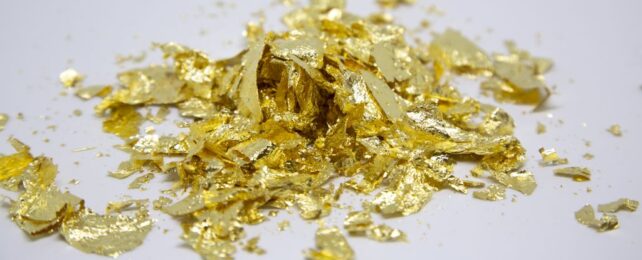For centuries, goldsmiths have sought ways to flatten gold into ever finer forms. An approach based in modern chemistry has finally created a gold material that literally can't get any thinner, consisting of a single layer of atoms.
Sticking to the naming conventions of materials science, researchers have named this new two-dimensional material 'goldene', and it has some interesting properties not seen in the three-dimensional form of gold.
"If you make a material extremely thin, something extraordinary happens – as with graphene," explains materials scientist Shun Kashiwaya of Linköping University in Sweden.
"The same thing happens with gold. As you know, gold is usually a metal, but if single-atom-layer thick, the gold can become a semiconductor instead."
Gold is quite challenging to coax into a two-dimensional configuration, due to its tendency to clump together. Previous attempts have resulted in either a thin sheet that is several atoms thick, or a monolayer sandwiched between or on another material, and unable to be detached.
Kashiwaya and his colleagues did not set out to make goldene, but stumbled across the first steps of their process by accident.
"We had created the base material with completely different applications in mind," says materials physicist Lars Hultman of Linköping University.
"We started with an electrically conductive ceramic called titanium silicon carbide, where silicon is in thin layers. Then the idea was to coat the material with gold to make a contact. But when we exposed the component to high temperature, the silicon layer was replaced by gold inside the base material."

So far so good. But as with other attempts to create monolayer gold, progress stalled at this critical step. For several years, the intercalated titanium gold carbide the team had created remained just that, with no way to extract the super-thin layers of gold from between the layers of titanium and carbon that sandwiched it.
This is where a technique based on an etching solution called Murakami's reagent comes in.
Murakami's reagent is a mixture of chemicals used in metalworking to etch away carbon and stain steel, resulting in the kinds of patterns seen on some Japanese knives.
They tried different concentrations of the mixture, and different timeframes for the etching process to eat away at the titanium and carbon surrounding the gold. The longer they let it sit, the better the results – but that wasn't all that the recipe required.
The etching effect of Murakami's reagent creates a by-product called potassium ferrocyanide. If exposed to light, the compound releases cyanide that dissolved the gold, so the etching process had to take place entirely in the dark.
Finally, the thin sheet of gold had a tendency to curl and clump, which was solved by adding a surfactant that prevented the layer from folding over and sticking to itself, maintaining the monolayer integrity. Further analysis revealed that these fiddly steps succeeded in finally forming stable goldene, just as theoretical simulations had predicted.
Usually, gold is an excellent conductor of electricity. When the element takes the form of a two-dimensional sheet, the atoms have two free bonds, transforming it into a semiconductor with conducting properties between a conductor and an insulator. These are useful because their conductivity can be tuned.
Gold already has properties that make it highly prized in chemical applications. Imbuing it with the properties of a semiconductor as well opens up a whole new range of ways we can use it, including water purification, communication, and chemical production.
The team's research has been published in Nature Synthesis.
